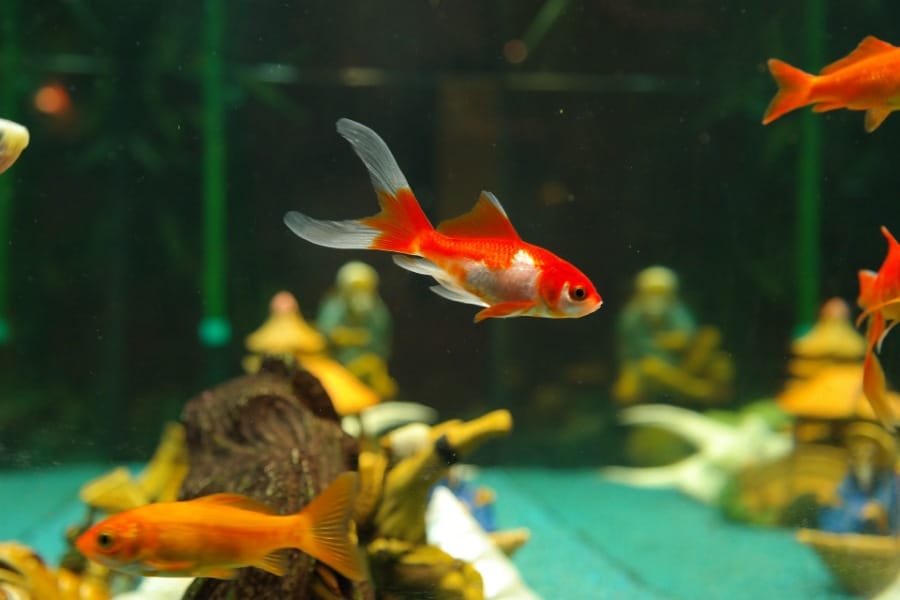If you’ve ever decided to raise a fish as a pet, you’ve no doubt come across the idea of choosing a goldfish.
But with them coming in all different shapes and sizes, it can be hard to determine which is best for you.
In this article, we hope to give you a comprehensive guide to all the types of goldfish you’re most likely to come across so that you can have a stress-free time when you visit the pet store to pick up your new fish.
The Background of Goldfish
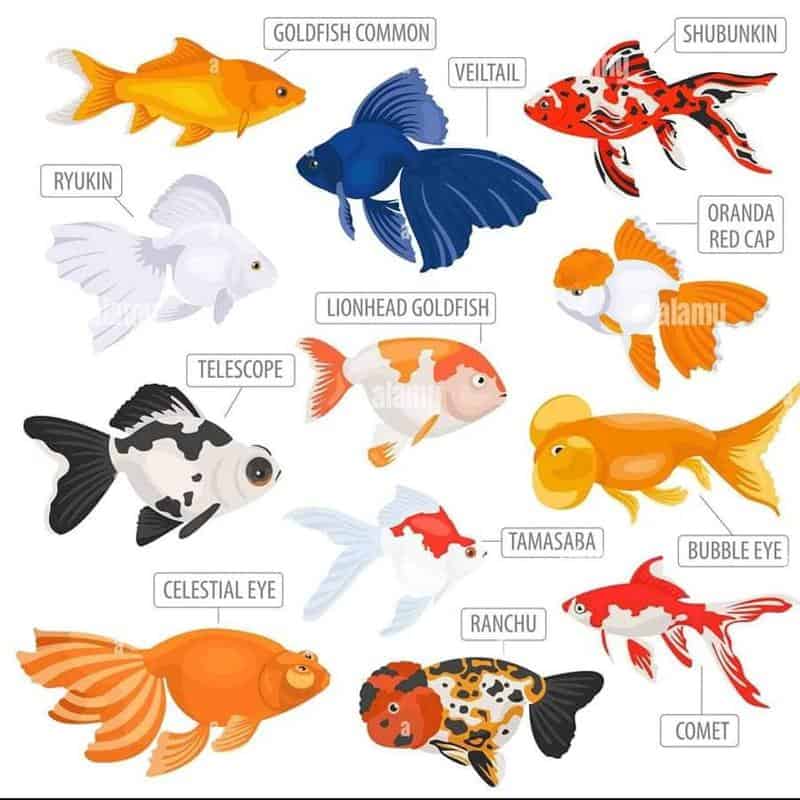
Goldfish are one of the most well-known fish species in the world, with them being present in nearly all public aquariums and fish tanks. Let’s have a closer look at how this came to be and learn a bit more about this fascinating species.
The Origins of Goldfish
Goldfish were first domesticated from the crucian carp, one of the most farmed fishes in global aquaculture today, in ancient China.
The appearance of red scales on the typically gray or silver crucian carp was first observed during the Chinese Jin Dynasty. In the Tang Dynasty, goldfish with the preferred physical traits were selected and bred in ornamental ponds and water gardens.
By the Song Dynasty, the golden variety of the goldfish was considered the imperial or “royal fish” and became known as the symbol of the imperial family.
By the beginning of the 17th century, goldfish were introduced to Japan and Europe, and by 1850 to North America, where their popularity quickly spread.
The Evolution of Goldfish
Goldfish are capable of laying thousands of eggs, and many of the resulting offspring can be raised in the same pond as their parents. Thus, they act as very good models for studying the genetics of morphological features.
Through the idea of evolution and its presence in goldfish, Darwin was able to determine that selection, either natural or artificial, was the key driver of evolution.
Shisan C. Chen, a modern Chinese geneticist was able to prove that mendelian inheritance was present in goldfish through the evolution of transparency and mottling.
After centuries of breeding, hundreds of changes in body shape, eye style, coloration, and other traits have made the goldfish one of the best genetic models for studying fish physiology and the general concept of evolution.
The goldfish was in fact one of the earliest models used to study mendelian genetics and variation before the discovery of zebrafish.
Common Types of Goldfish
1. Common Goldfish
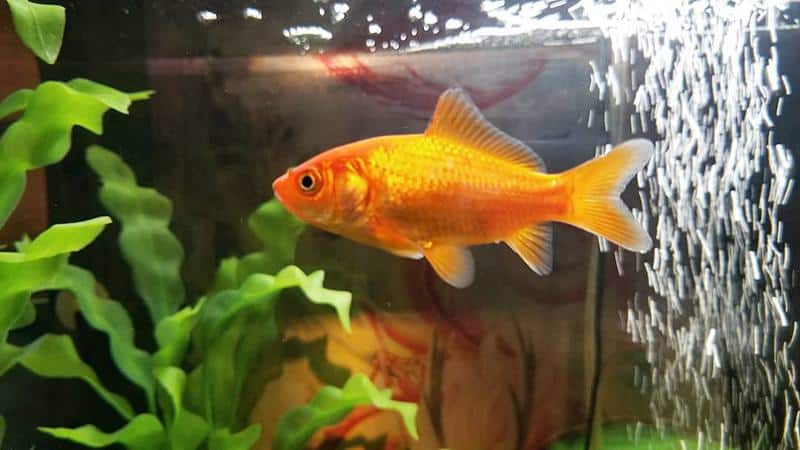
The common goldfish is probably the type of goldfish we’re used to seeing the most in our local pet stores.
They are quite inexpensive and can tolerate a wide range of temperatures (they don’t need a heater and can survive in tropical set-ups, making them affordable and easy to care for.
Common goldfish may or may not be feeder goldfish depending on the store. Though prettier and larger than feeder goldfish, common goldfish are typically more expensive.
Appearance
Common goldfish can appear plain grey or brown. Other colors more typical of the common goldfish include red/orange and white/silver.
The common goldfish can either be bi-colored or mono-colored.
Diet
The common and feeder goldfish diet includes commercially available goldfish flakes or pellets combined with fresh/frozen foods such as brine shrimp.
2. Comet Goldfish
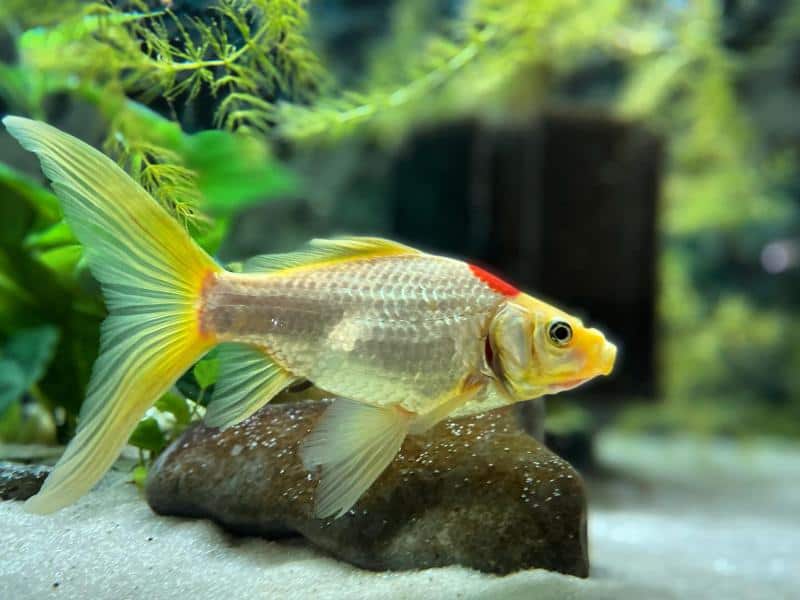
Similarly, to the common goldfish, the Comet goldfish is another extremely popular type of goldfish found in many pet stores. They are also very tolerant of a range of temperatures, so they can be kept in both ponds and heated aquariums.
Appearance
The Comet goldfish usually comes in colors such as red or orange, and are either bi-colored or mono-colored. If they’re bi-colored, it’s usually a combination of red and white.
Comet goldfish have shorter and leaner bodies than the common goldfish, yet their tails are very long and widespread with sharp points.
Diet
The Comet goldfish’s diet consists of either goldfish flakes or pellets supplemented with either live or frozen foods such as brine shrimp.
3. Oranda Goldfish
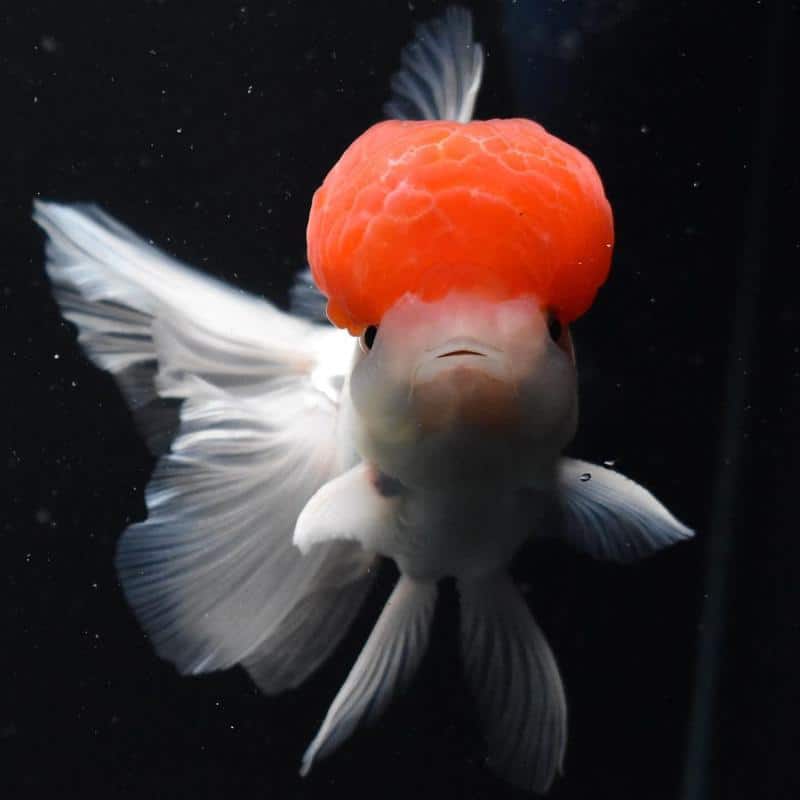
The Oranda goldfish is a result of selective breeding and consists of a unique trait and many colors that make it a favorite among goldfish owners. They are quite peaceful and can live with other temperate fish of similar size.
Appearance
The adults are about 8 to 9 inches long, and their most distinctive trait is the fleshy overgrowth present on the top of their heads. This may cover only the top of their head or sometimes the entire face.
Colors include orange, yellow, black, and blue.
Red cap Orandas are very popular and have white bodies with bright-red head caps. Tigerhead Orandas have their cap growing over their entire head.
Diet
These fish prefer high-quality goldfish flakes with live/frozen food such as shrimp and bloodworms.
4. Ranchu
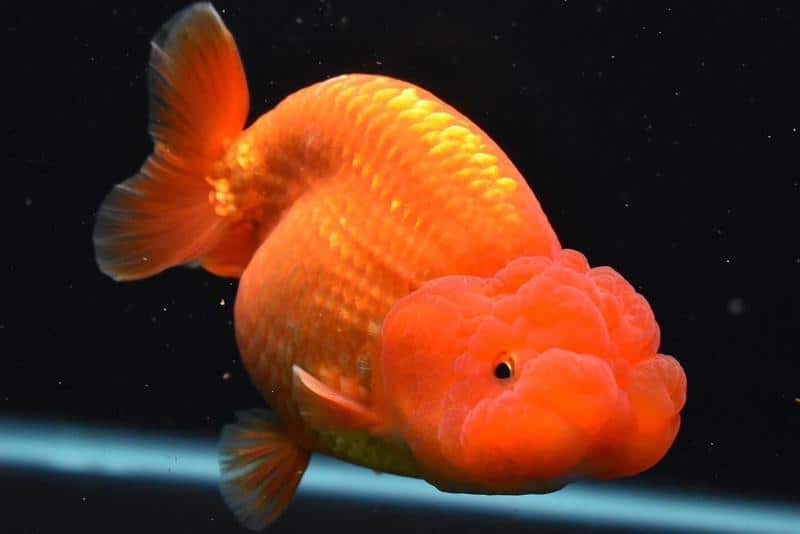
The Ranchu is one of the oldest breeds of goldfish in Japan and is known as the “King of the Goldfish” there due to its reputation.
These goldfish are not as adaptable as some of the others we’ve seen and thus, are best kept in a temperature-stabilized aquarium with similar goldfish types.
Appearance
The Ranchu appears similar to the Lionhead goldfish, but the former has a less noticeable hood and a broader back. It doesn’t have a dorsal fin, and, combined with its wide-spread double tail, hampers its ability to maneuver in the water.
Most of the Ranchu are bi-colored, but mono-colored ones are also available. Typical colors include a combination of red and white, a combination of gold and white, pure white, and a combination of black and red/yellow.
Diet
As mentioned earlier, due to its wide tail and lack of dorsal fin, the Ranchu can’t maneuver well in the water. Thus, they are best fed a diet of goldfish pellets that can float and live/frozen food like bloodworms or brine shrimp.
5. Shubunkin Goldfish
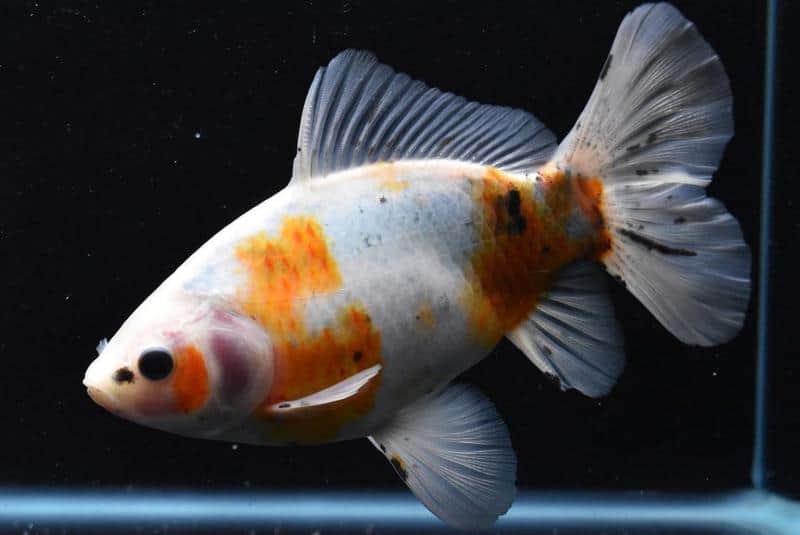
The Shubunkin goldfish is an interesting type of goldfish in that it’s characterized by having a particular type of scale. All goldfish regardless of the type, that has a single calico-colored tail are known as Shubunkin.
Appearance
What makes the Shubunkin goldfish unique is the addition of a calico-colored tail. Calico is referring to a unique type of scale that is something in between the metallic and transparent types of scale.
There are three subtypes of Shubunkin goldfish that are distinguished by their appearances:
American/Japanese Shubunkin: Distinguishable by its longer tail consisting of sharp points and a deep fork. Typically considered the original Shubunkin
Bristol Shubunkin: Similar in appearance to the comet goldfish but with a large pointed tail
London Shubunkin: Consists of a slender body with shorter and rounder tail fins
All three usually appear blue with white, black, or orange patches. The calico scales can make them appear blue/purple in certain lighting conditions.
Diet
Commercially available goldfish flakes or pellets with additional live/frozen foods such as shrimp.
6. Lionhead Goldfish
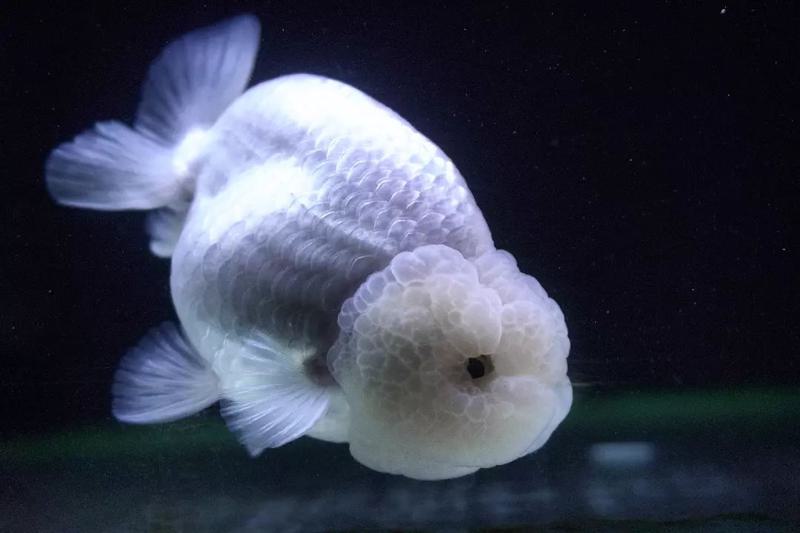
The Lionhead goldfish is no doubt the most common type of dorsal-less goldfish. Similar to the Ranchu, the lack of the dorsal fin makes the Lionhead an awkward swimmer, hence they do best in warmer aquariums with other similarly fragile breeds.
Appearance
The Lionhead looks very similar to the Ranchu and has the classic double tail, with the notable exception of a flatter back. They typically have a large hood that covers their entire head and face, however, this trait is not always present and can sometimes be limited to the top of the head only.
The Lionhead can be mono, bi, and tri-colored, with calico also being observed. Typical colors include red, orange, brown, black, blue, calico, and a combination of either red and white or black and white.
Diet
Similar to the Ranchu, the Lionhead prefers goldfish pellets that can float, along with live/frozen food such as bloodworms, brine shrimp, or Daphnia.
7. Bubble Eye Goldfish
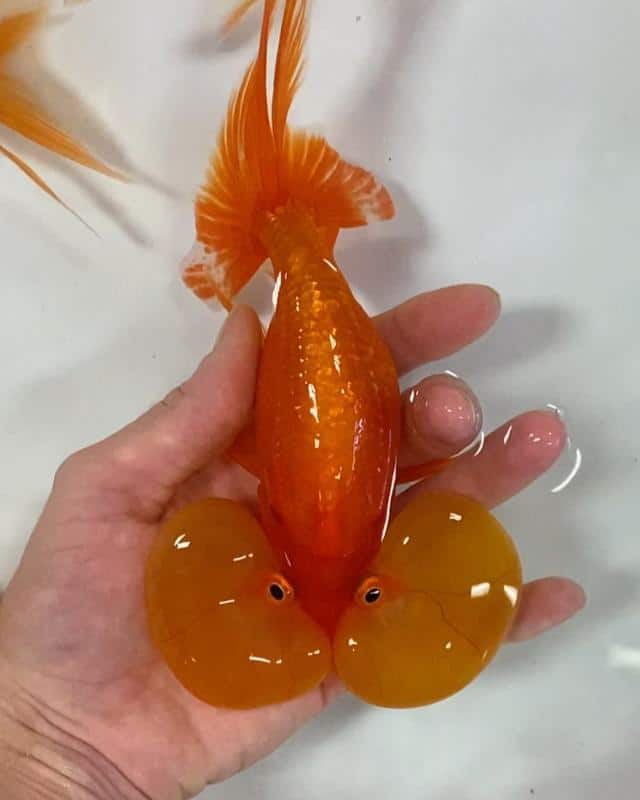
The Bubble Eye goldfish is one of the most peculiar-looking fancy goldfish out there and, as a result, is commonly kept in aquariums. They are not found in the wild and are exclusively captive-bred.
Though most of the goldfish we’ve looked at are relatively easy to take care of, you’ll need a bit more preparation to take on the Bubble Eye.
Appearance
The Bubble Eye goldfish will grow to about 5 inches long as an adult. Per its namesake, the Bubble Eye has two distinct fluid-filled sacs on each cheek.
The sacs, though pretty to look at, are quite fragile and can affect the way the fish swims. They also have a distinctive double tail and lack the dorsal fin.
Typical colors include solid gold, orange, red, brown, or white. They can also have multiple colors such as a combination of red and white, red and black, or a calico pattern.
Diet
The Bubble Eye goldfish is an omnivore that is best-fed goldfish pellets instead of floating flakes as these fish are known to ingest air when they eat.
The food can be supplemented with live/frozen food such as bloodworms and daphnia, as well as some small fruits and vegetables.
8. Telescope Goldfish
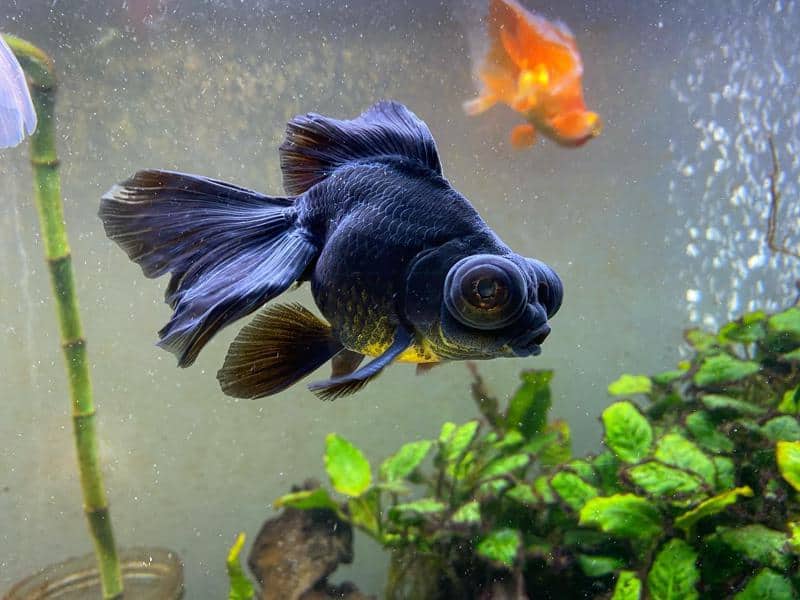
The telescope goldfish are believed to have been descended from wild carp and are one of over 125 captive-bred varieties of the fantail goldfish.
Appearance
The telescope goldfish is a type of fancy goldfish, consisting of a round or egg-shaped body, a wide head, and a split tail (caudal) fin that can either be of moderate or long length.
Its eyes are large and protrude from the head on long stalks that are mounted on the sides of the head.
The telescope goldfish comes in a wide range of colors, such as red, blue, brown, white, and calico. The fish can be either bi or tri-colored.
Diet
Similar to most goldfish, the telescope goldfish also prefers goldfish flakes or pellets along with a supply of live/frozen foods such as shrimp. It will consume algae and some plants in the tank as well.
Also Read: Fish With Big Eyes
9. Ryukin Goldfish
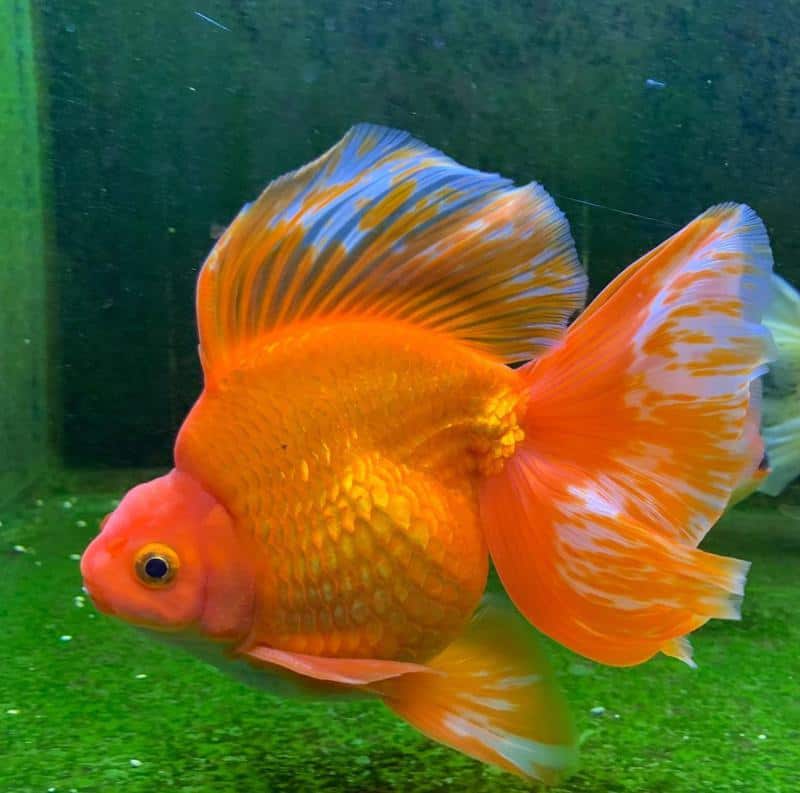
The Ryukin goldfish is a descendant of the Fantail goldfish and helped pave the way for other double-tailed types such as the Watonai and butterfly goldfish. They are overall one of the easiest “fancy” goldfish to maintain.
This goldfish thrives in ponds and prefers warmer temperatures, which can be accomplished with a heater. Considering its also very compatible with other goldfish types, the Ryukin is a good option if you’re looking for small goldfish breeds.
Appearance
This goldfish has a round body with a noticeable humped back, which makes them look as tall as they are long, along with the classic double tail. Those with longer tails are sometimes known as ribbon or fringe tailed.
The Ryukin can appear mono, bi, or tri-colored. Calico subtypes are also well documented. Common colors include red, a combination of red and white, calico, and a combination of brown and white.
Diet
The Ryukin prefers goldfish flakes or pellets along with live/frozen foods such as shrimp or bloodworms.
10. Veiltail Goldfish
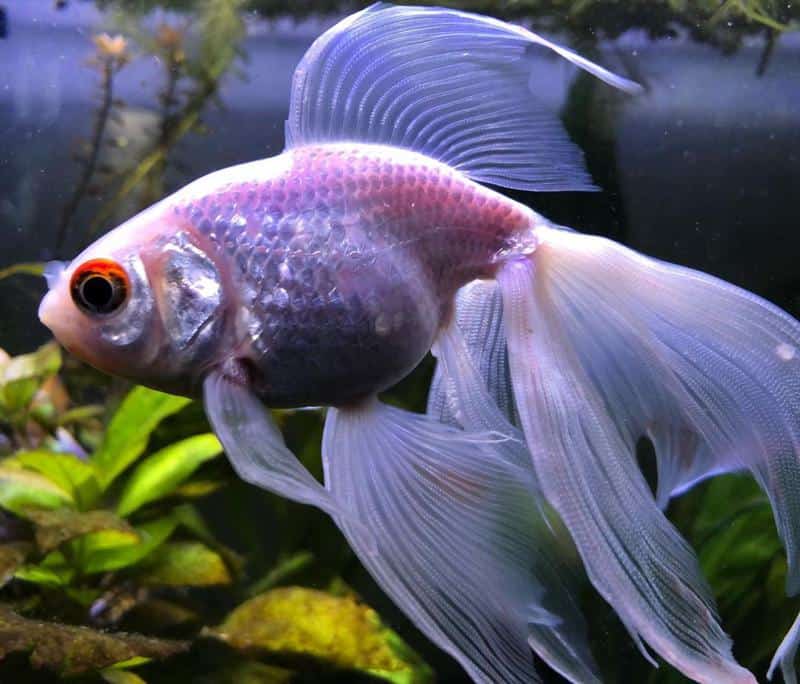
If you prefer a more extravagant fish than the Fantail and don’t mind a challenge, then the Veiltail goldfish might be the one for you.
The Veiltail is very similar to betta fish due to its extremely long tail and dorsal fin, however, the length comes at a price in that they limit the fish’s movement and can be easily damaged by the décor. They need plenty of room to move around in your tank, and are considered too fragile for community aquariums.
Appearance
The Veiltail has a rounder yet slightly more compact body than the Fantail, but what truly makes them stand out is their 4-inch long tail and dorsal fin.
The Veiltail typically appears as bi or mono-colored, but calico subtypes may also be present. Typical colors include red/orange or red and white.
Diet
Because their extremely long tail and fin prevent them from being proficient swimmers, the Veiltail is best fed a floating diet consisting of goldfish pellets and live/frozen food such as shrimp.
This way, they can easily see and reach for the food instead of having to swim around chasing after it.
11. Celestial Eye Goldfish
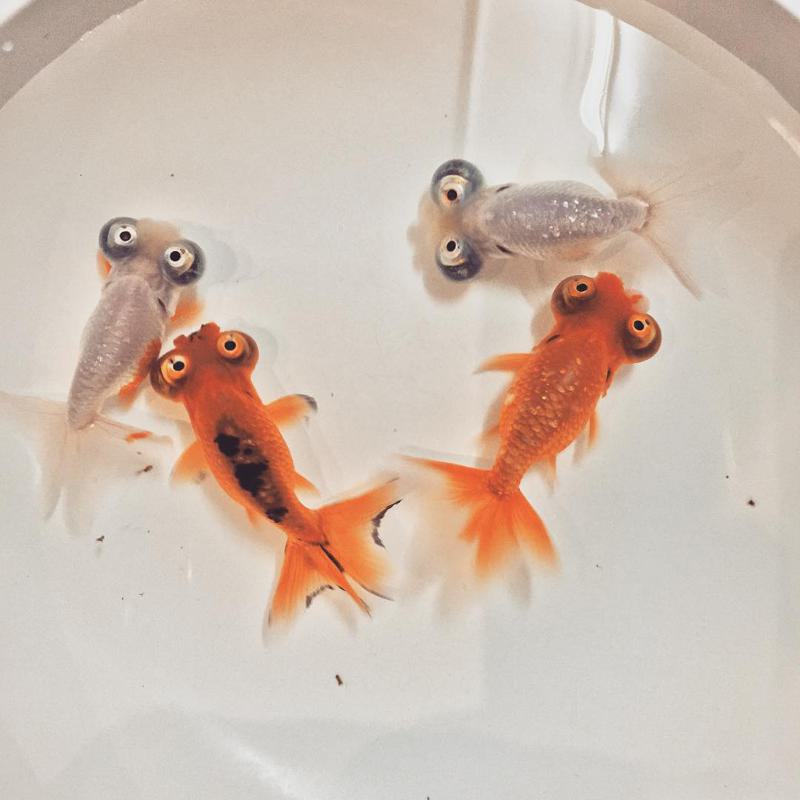
The Celestial eye goldfish is also known as the stargazer and is a result of selective breeding that began as a mutation.
Appearance
The main trait of this fish is its eyes that bulge out of its head. They lack a dorsal fin and have large caudal and tail fins, hence making maneuvering in the water somewhat of a challenge.
Typical colors include solid black, orange, or calico.
Diet
The celestial eye consumes the typical goldfish diet consisting of goldfish flakes or pellets supplemented by vegetables and live/frozen food such as brine shrimp.
12. Tamasaba/Sabao Goldfish
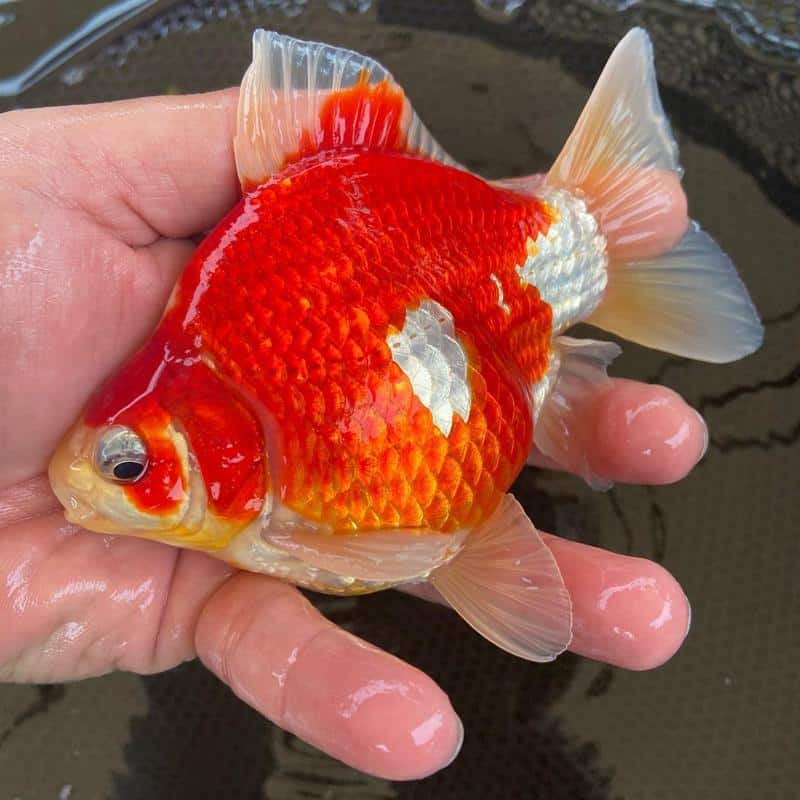
The Tamasaba goldfish is a rare Japanese goldfish that is originally bred from the Ryukin goldfish.
They make excellent additions to koi ponds where their appearances blend very well with that of the leaner koi. They can also be placed in large aquariums, but they should avoid other types of single-tailed goldfish.
Appearance
The Tamasaba goldfish consists of a round, egg-shaped body with an arched back and a long single tail with smoothed points.
They are either bi or mono-colored, with typical colors including red/orange or red and white.
Diet
As with the previous goldfish, the Tamasaba also consume goldfish flakes/pellets along with live/frozen foods such as shrimp.
13. Fantail Goldfish
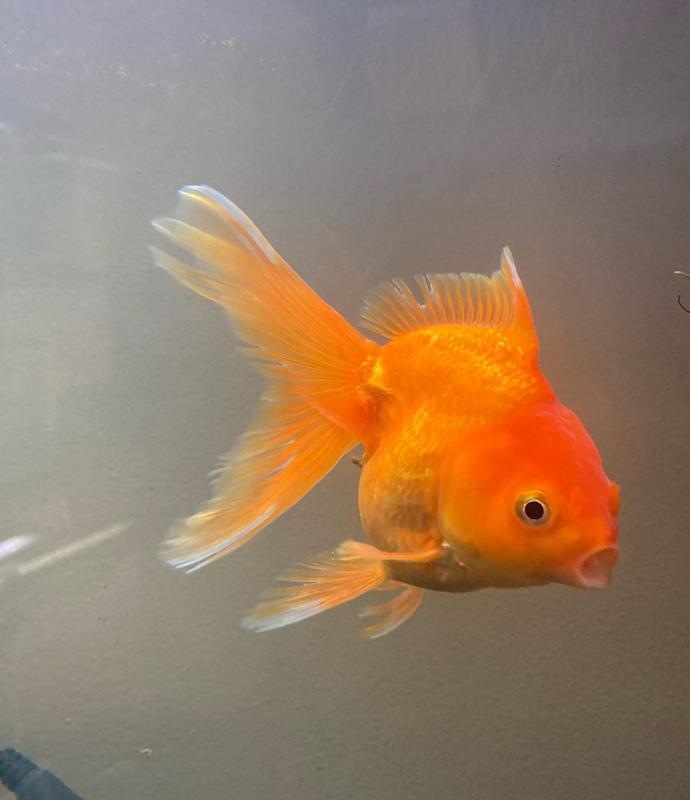
The Fantail is the go-to goldfish if you’re looking to fancy goldfish. They require a bit more care than the single-tailed goldfish we’ve looked at but are still overall simple to maintain.
The Fantail prefers warmer waters and will usually require an aquarium heater, but other than this, they don’t need much more special care to thrive.
Appearance
The Fantail goldfish consists of an egg-shaped body with a long double tail. Those that have particularly long tails are sometimes coined “ribbon-tailed Fantail”.
The Fantail goldfish come in either bi or mono-colors, with red and white being the most common, but calico subtypes also exist. Other colors may include red/orange, yellow, black, white, and koi-colored subtypes.
Diet
A typical diet for the Fantail includes goldfish pellets supplemented with live/frozen foods such as shrimp. Goldfish flakes are not preferred as the Fantail are not as strong swimmers as some of the other single-tailed goldfish we’ve looked at earlier.
14. Pearlscale Goldfish
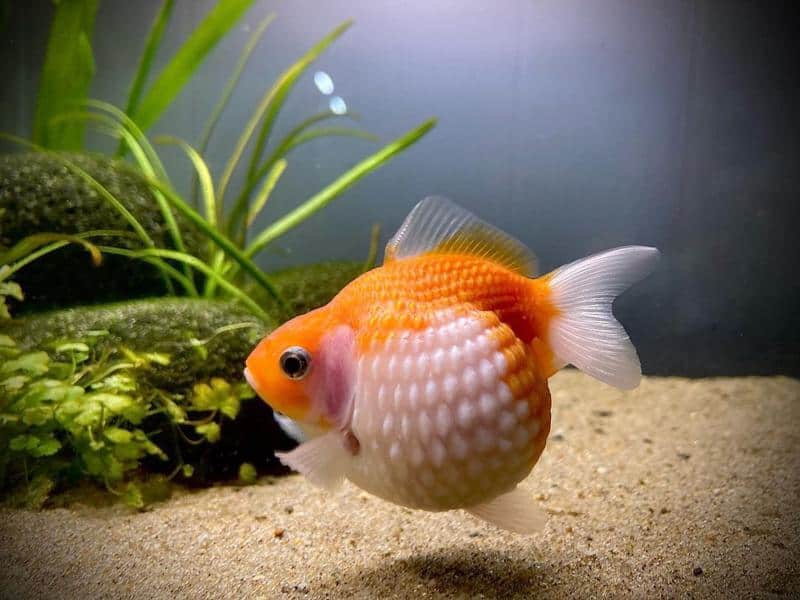
The Pearlscale goldfish is another beautiful fish that would make a great addition to your aquarium, however, they can be on the difficult side when it comes to maintenance.
Appearance
The Pearlscale has a noticeably round belly covered with raised bead-like scales. The tailfin has split lobes to make it appear forked.
Colors include orange, red, white, black, blue, brown, and calico. Bi-colored patterns are the most common.
Diet
Dry goldfish flakes and pellets combined with calcium is preferred, but its best soaked first. Protein should be limited to about 30% of their diet, while the rest should include vegetables such as lettuce and cucumbers.
15. Wakin Goldfish
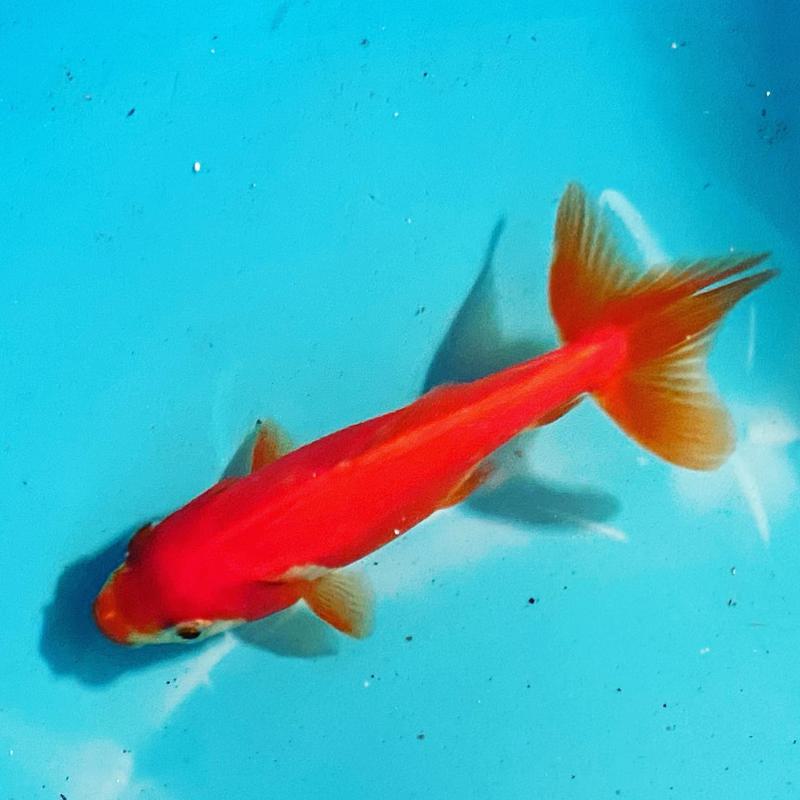
The Wakin goldfish is another goldfish that is relatively easy to take care of and does well in both ponds and aquariums.
They don’t have any particular requirements other than needing ample space for them to swim and grow in. Some that were raised in ponds have been known to grow up to 19 inches in length.
Appearance
The Wakin goldfish is a lean goldfish with an upright dorsal fin that extends along its spine along with the classic double tail. They are typically described as a hybrid between the common/comet goldfish and the fancy Fantail.
This fish is typically mono or bi-colored but has since been bred into a calico subtype. Common colors include red or a combination of red and white, along with dark brown, yellow/orange, and calico.
Diet
The Wakin goldfish feeds on the typical commercially available goldfish flakes or pellets combined with live/frozen foods such as shrimp.
16. Pompom Goldfish
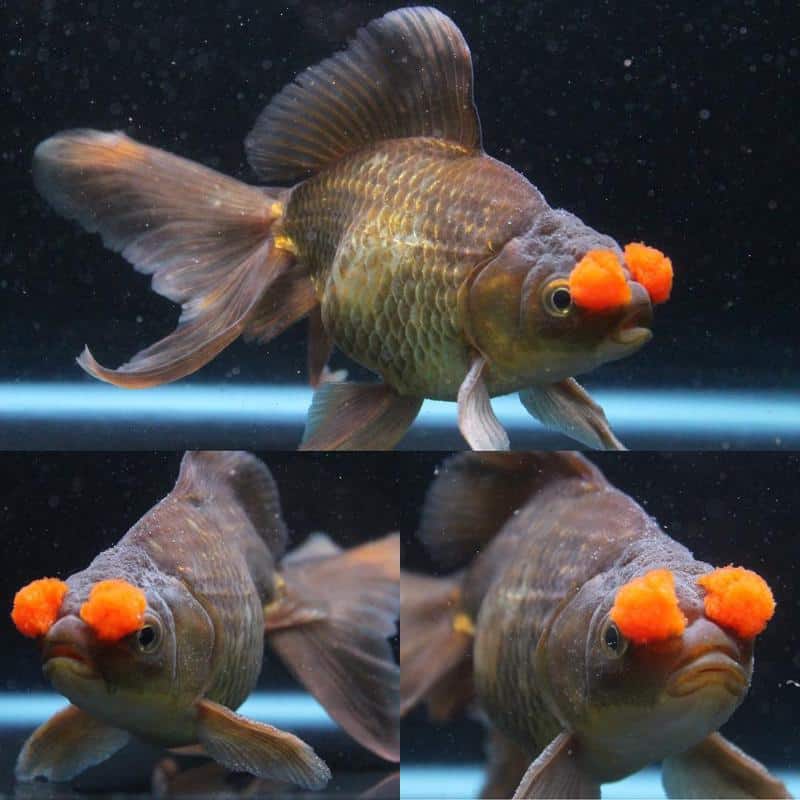
The Pompom goldfish is a unique and fancy fish that is considered exotic.
Appearance
Per its namesake, this goldfish has two loose and fleshy growths on each side of the head between the nostrils.
Typical colors include silver, orange, yellow, and a combination of black and white.
Diet
The typical diet for this fish includes goldfish flakes and pellets, along with a supplement of bloodworms and shrimp.
17. Tosakin Goldfish
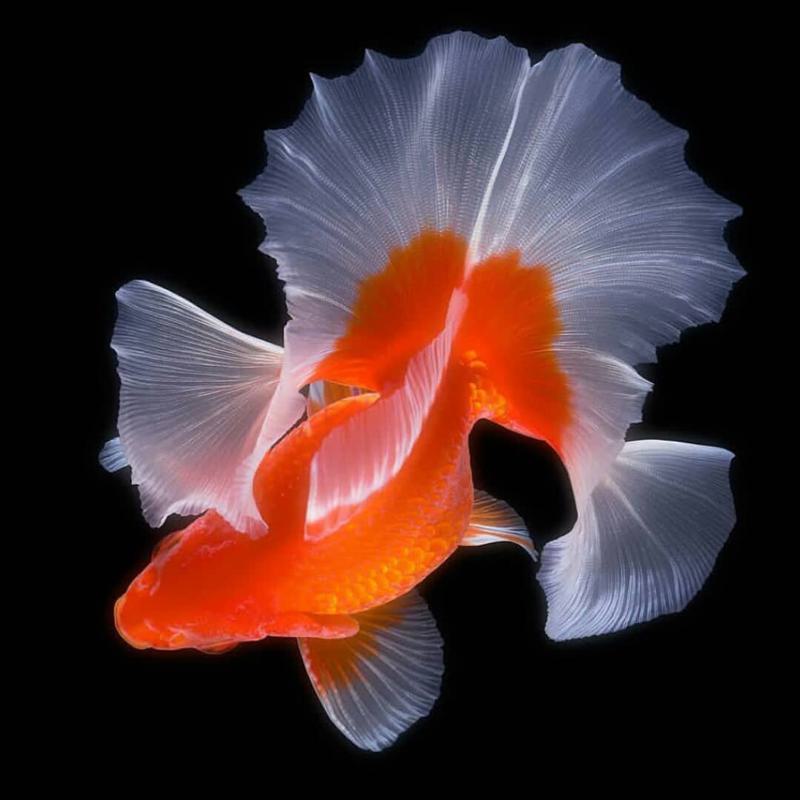
The Tosakin goldfish is one breed that is rarely found outside of Japan since only 6 were left alive after natural disasters and World War II destroyed much of the region where they were first bred. One goldfish enthusiast by the name of Hiroe Tamura saved these last remaining fish and re-established them in the country.
Appearance
The Tosakin goldfish, with its compact body, appears similar to the hunched Ryukin at first, but it has a very wide-spread double tail that is attached instead of separated. The tail is at its prettiest when viewed above, where it can look like a long flowing skirt in the water.
This fish is mono or bi-colored and comes in colors such as red, black, or a combination of red and white. Calico has been documented but is overall quite rare.
Diet
Similar to some of the other types we’ve looked at so far, the Tosakin is not an efficient swimmer due to its large and wide tail. Hence, it’s best to feed it goldfish pellets that can float, along with live/frozen foods like bloodworms.
18. Butterfly Tail Goldfish
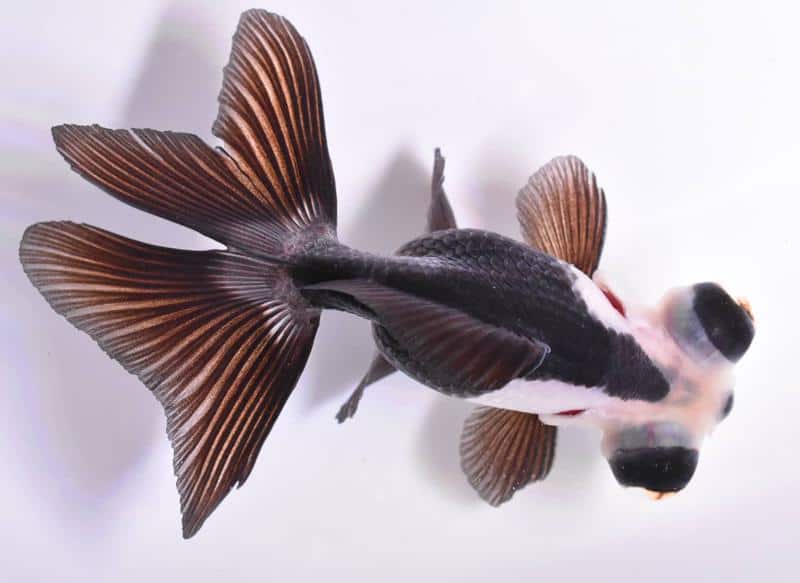
Similar to the Veiltail, the Butterfly Tail goldfish were also bred for their fancy fins, which is best viewed from above. They are very popular with breeders and, as a result, have come to bare various scale types, patterns, and colors.
Appearance
The Butterfly Tail goldfish consists of a round, hunched body with a long, widely-separated double tail. Per its namesake, the Butterfly Tail goldfish’s tail creates the illusion of a butterfly when viewed from above.
Besides its mesmerizing tail, this goldfish also comes with telescopic eyes, hoods, or other fancy traits as common in the butterfly moor subtype.
Typical patterns for this goldfish include mono and bi-colors, but tri-colored appearances and calico subtypes have also been observed.
Black and white are the most common colors, but other colors, such as red and black/red and white/pure black/red, black, and white have also been seen.
Diet
Similar to the Veiltail, the Butterfly Tail goldfish can’t swim very well due to its long tail. Therefore, the best way to feed it would be through goldfish pellets that can float, in addition, to live/frozen food such as shrimp.
19. Watonai Goldfish (Wakin Hybrid)
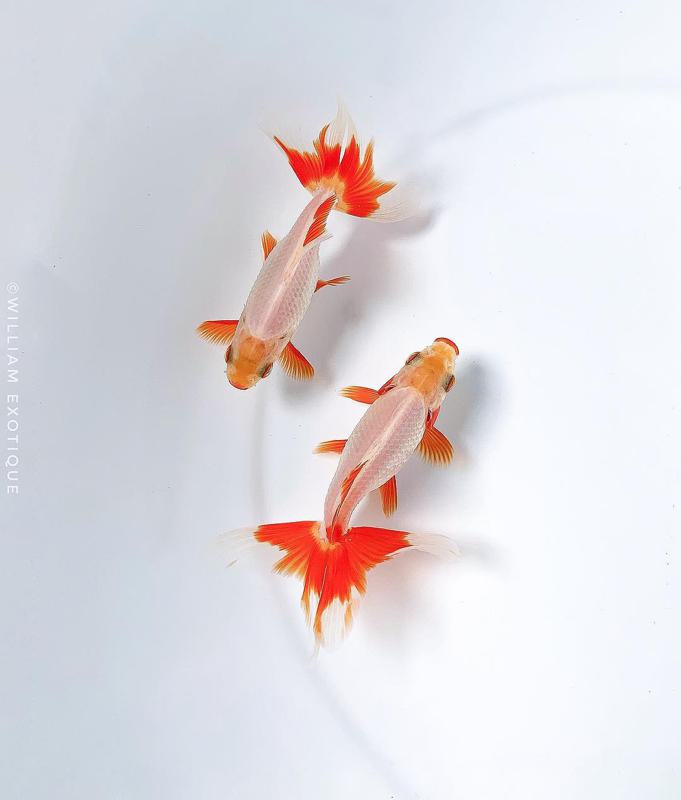
The Watonai goldfish is a relative of the Wakin goldfish and appear very similar. They also have similar requirements and are considered some of the most beautiful goldfish types one can have in a pond.
Appearance
The Watonai goldfish appears very similar to the Wakin goldfish, with the notable exception of a longer double tail.
The Watonai and Wakin goldfish share the same overall shape and colors.
Diet
This goldfish consumes the typical goldfish flakes/pellets along with live/frozen foods like shrimp.
20. Jikin/Peacock Goldfish
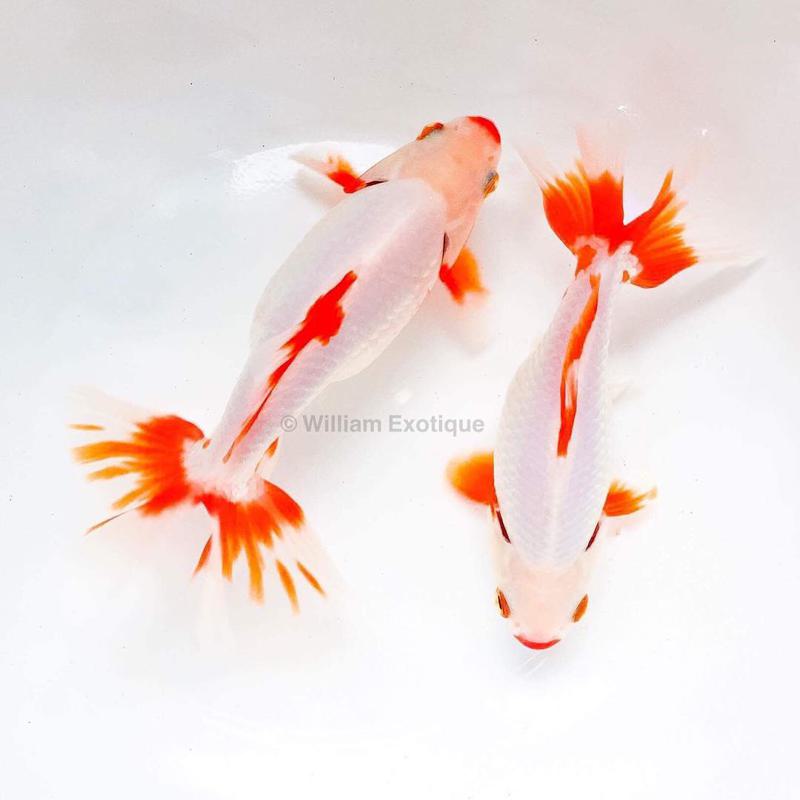
Another type of goldfish that is sometimes nicknamed the butterfly goldfish is the Jikin/Peacock goldfish.
This goldfish is bred very specifically to a specific color standard, thus they’re a bit more rarely seen than some of the other fancy goldfish we’ve looked at.
Appearance
The Jikin/Peacock goldfish has a longer-than-average body that is similar in length to the common goldfish (though some may have the distinctive hunch of the Ryukin), along with a wide-spread tail that is best viewed from above. This wide tail is what gave them their nickname as the butterfly or Peacock.
The main trait that makes the Jikin/Peacock stand out is its color pattern. Their color pattern is always bi-colored with a combination of red and white, however only the tail, fins, gill covers, and lips should be red; all other areas that may contain red are selected against.
Diet
The Jikin/Peacock goldfish can be fed the traditional goldfish flakes or pellets, along with live/frozen food such as shrimp. They are overall omnivores that require a varied diet consisting of proteins and plant matter, such as green algae.
21. Dragon Eye Goldfish
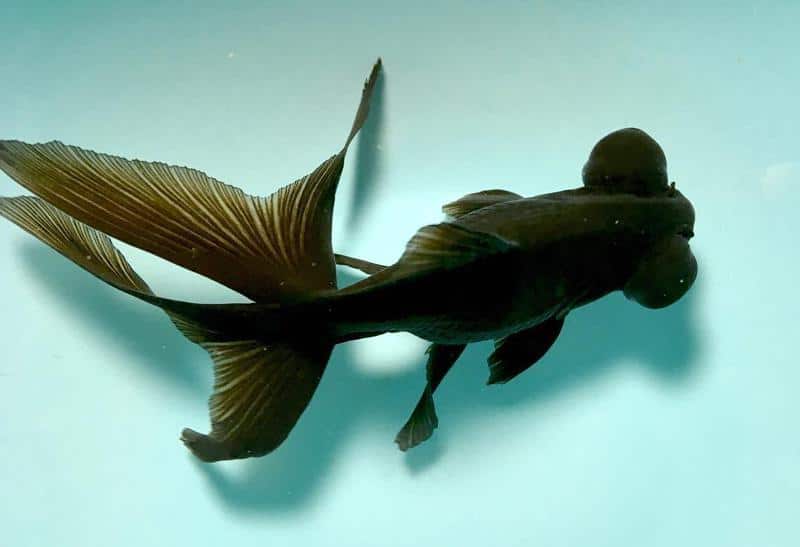
The Dragon Eye goldfish is a variety of the Moor fantail goldfish and can be a colorful addition to your cold-water fish tank. They are, however, somewhat difficult to care for and are not recommended for beginner goldfish keepers.
Appearance
The Dragon Eye goldfish can grow up to 6 inches in length, and they typically grow the quickest in their first two years. Therefore, it’s best to buy a large fish tank in advance.
They are named for their eyes that sit on ¾ inch stalks on either side of their head. They have a round body and a distinctive wobbling swimming style.
Typical colors include red, blue, white, brown, black-and-white, black moor, and calico. They are either bi or tri-colored.
Diet
As omnivores, the Dragon Eye typically eats a combination of fancy goldfish pellets and flakes, frozen protein, and blanched vegetables such as peas and zucchini.
22. Nymph Goldfish
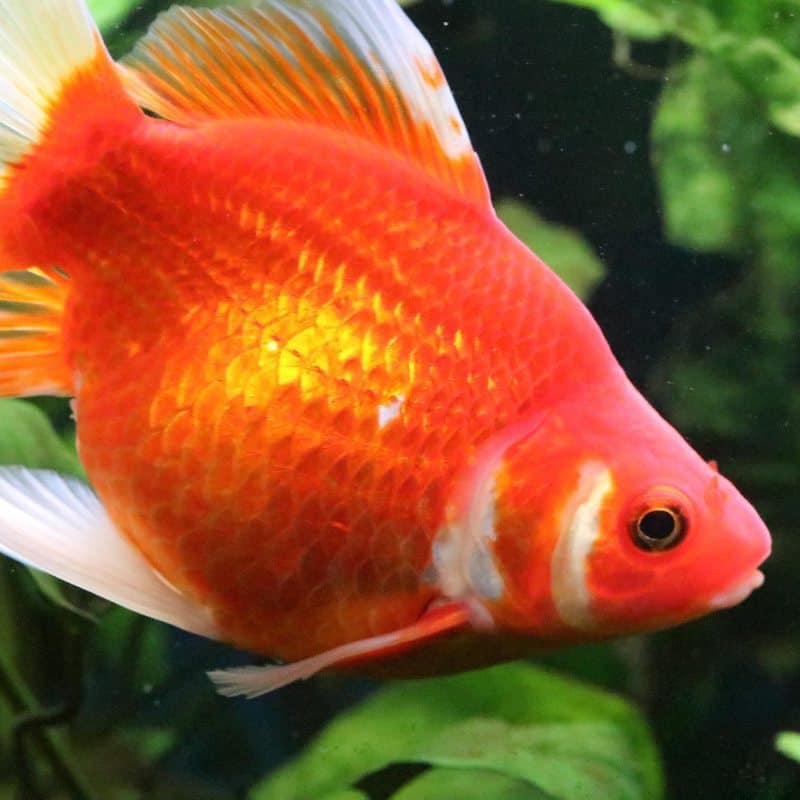
Nymph goldfish were the norm roughly 15 years ago, but have since become somewhat obsolete. These fish are very great swimmers and are easy to maintain in a pond or large aquarium.
Appearance
The Nymph goldfish, despite its name, is a rather large fish, growing up to 12 inches in length. They are typically mono or bi-colored, with typical colors including red/orange, white, yellow, green, or dark brown.
They are often thought to be the hybrid between a comet goldfish and a fancy Fantail goldfish due to them having an egg-shaped body and a single tail.
Diet
Similar to most goldfish, the Nymph goldfish also prefers goldfish flakes or pellets along with a supply of live/frozen foods such as shrimp.
Fancy Goldfish Types
Of all the goldfish types we’ve seen so far, these are the types that are considered fancy:
- Fantail
- Veiltail
- Butterfly tail
- Wakin
- Watonai
- Ryukin
- Jikin/Peacock
- Tosakin
- Ranchu
- Lionhead
- Bubble eye
- Dragon eye
- Celestial eye
- Pompom
- Oranda
- Pearlscale
Related: Best Smallest Goldfish Breeds
Rare Goldfish Species
The following types of goldfish are typically only found in Asia and very limited numbers, hence information on them can be scarce.
1. Izumo Nankin
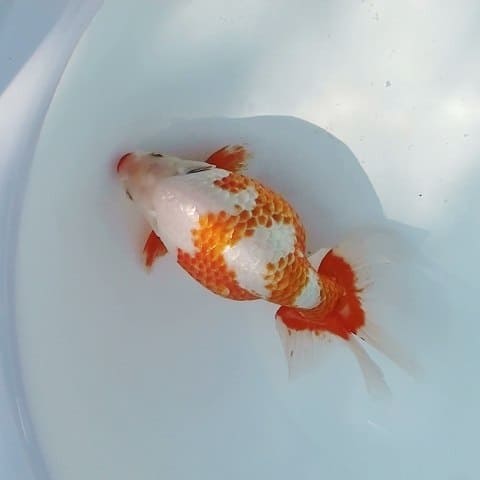
The Izumo nankin is a Japanese breed of goldfish that has rarely been seen in the west outside of Japan. It is best viewed from above.
Appearance
The Izumo nankin is a dorsal-less goldfish that consists of a somewhat fused Ranchu-looking tail.
They may have a mutation leading to curling gill covers that expose the gills underneath. Any that do is typically considered undesirable and, if seen in an aquarium, it is recommended not to purchase them as they are most likely unhealthy.
Diet
As omnivores, the Izumo nankin consumes both protein-based pellets and goldfish peas.
2. Eggfish/Egg-fish/Maruko Goldfish
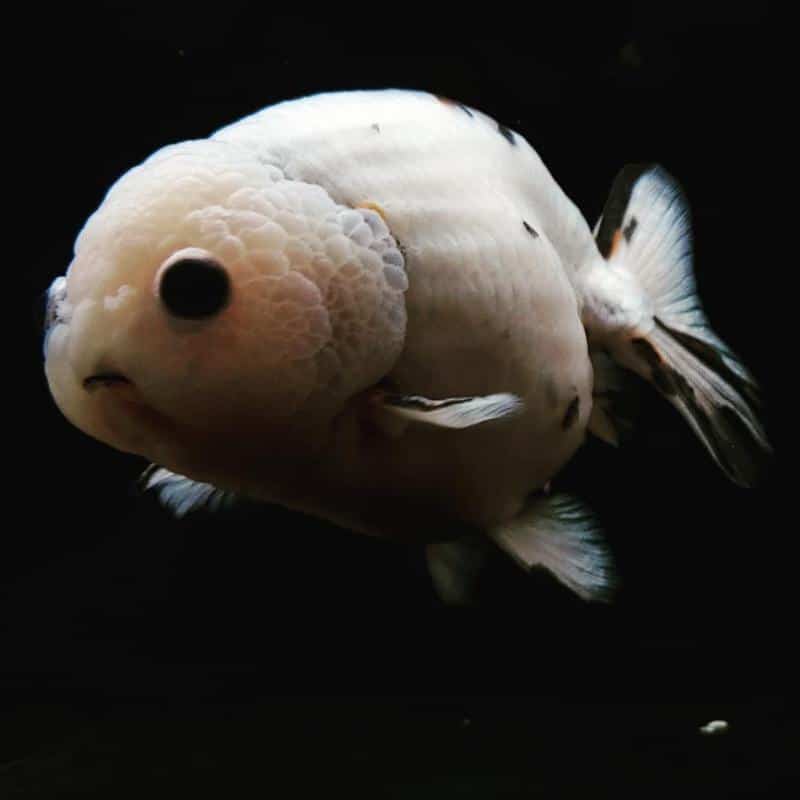
The Maruko goldfish is thought to be the ancestor of all the dorsal-less goldfish we’ve placed on this list. However, they are so rare that they’re currently not available for purchase.
As they are so old, many breeders have tried to reintroduce them from the Ranchu, however, there isn’t enough of them yet to be allowed back onto the commercial market.
3. Siamese Doll Goldfish
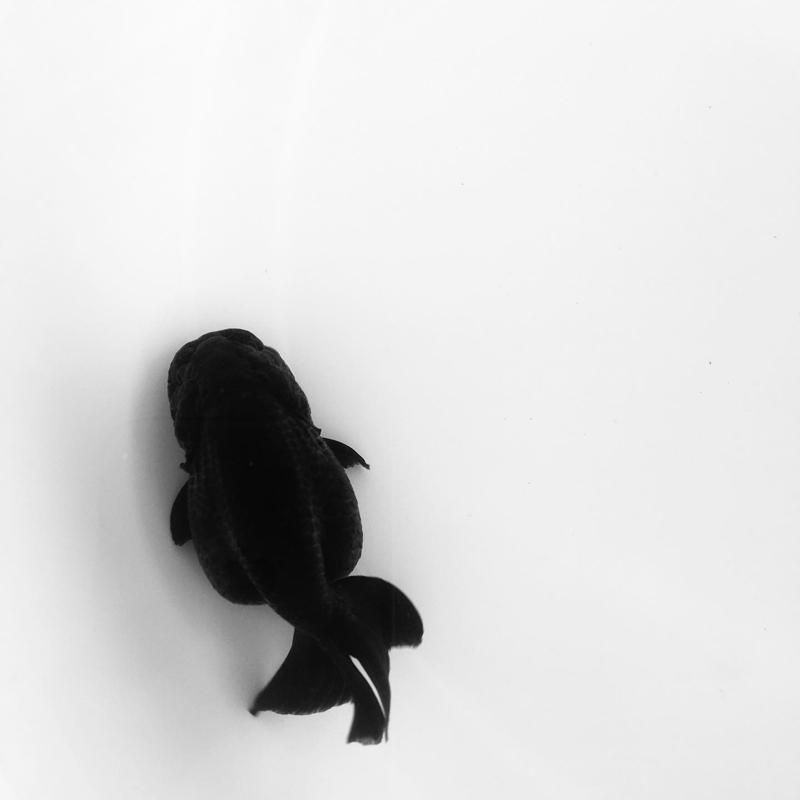
The Siamese Doll goldfish, sometimes nicknamed the Lutino, is a subtype of the Fantail that consists of a yellow coloration. They are extremely small and require much less space than the common goldfish.
Appearance
The Siamese Doll goldfish have large telescopic or cone-like stalks on the sides of their head. They have red eyes, a somewhat stout body, and a split caudal tail that is slightly forked.
Diet
The Siamese Doll goldfish has poor vision and are easily outcompeted by other, more agile goldfish. Hence, they need to be fed multiple times to ensure they have a healthy diet.
Similar to other goldfish, this breed is also an omnivore that prefers goldfish flakes or pellets, as well as fresh/frozen food such as brine shrimp.
Read More:
- What Do Goldfish Eat? What if Out of Fish Food?
- Perfect Goldfish Water Temperature
- How Often to Feed Goldfish? Schedule & Right Amount
- Can Angelfish Live with Goldfish: Why Separate Them?
- Do Goldfish Need an Air Pump?
- Ideal Tankmates for Your Goldfish
- What Kind of Water Do Goldfish Need?
- Do Goldfish Sleep?
- Goldfish Tank Size
FAQs
1. Can Different Types of Goldfish Live Together?
Different types of goldfish can live together, however, this is very dependent on the exact breed.
In general, more agile fish shouldn’t be placed together with slower ones as the former can cause the latter to starve to death due to it outcompeting it for food.
For example, the common goldfish can do very well with other goldfish of similar appearances such as comets or Shubunkins. On the other hand, placing the common goldfish with something like the Siamese doll goldfish probably won’t be a great idea as the former can easily pick all the food out before the latter can reach it.
2. How Many Different Types of Goldfish Are There?
There are over 120 varieties of goldfish around the world.
Conclusion
Overall, you can probably see that the goldfish is quite an extensive species, to say the least.
From all the information we’ve gathered, I hope you’ve been able to get at least a general understanding of some of the most common goldfish types you’re most likely to see.
